1998 PONTIAC GRAND PRIX service
[x] Cancel search: servicePage 2 of 402

The 1998 Pontiac Grand Prix Owner’s Manual
1-1
2-1
3-1
4-1
5- 1
6-1
7- 1
8-1
9-1
Seats and Restraint Systems
This section tells you how to use your seats and safety belts properly. It also explains \
the “SRS” system.
Features and Controls
This section explains how to start and operate your vehicle.
Comfort Controls and Audio Systems
This section tells you how to adjust the ventilation and comfort controls and how to operate \
your audio system.
Your Driving and the Road
Here you’ll find helpful information and tips about the road\
and how to drive under different conditions.
Problems on the Road
This section tells what to do if you have a problem while driving, such as a flat tire or overheated engine, etc.
Service and Appearance Care
Here the manual tells you how to keep your vehicle running properly and looking good.
Maintenance Schedule
This section tells you when to perform vehicle maintenance and what fluids and lubrica\
nts to use.
Customer Assistance Information
This section tells you how to contact Pontiac for assistance and how to get service and owner publications.
It also gives you information on “Reporting Safety Defects” on page
8-10.
Index
Here’s an alphabetical listing of almost every subject in this manual. You can use it to quickly find
something you want to read.
i
Page 3 of 402
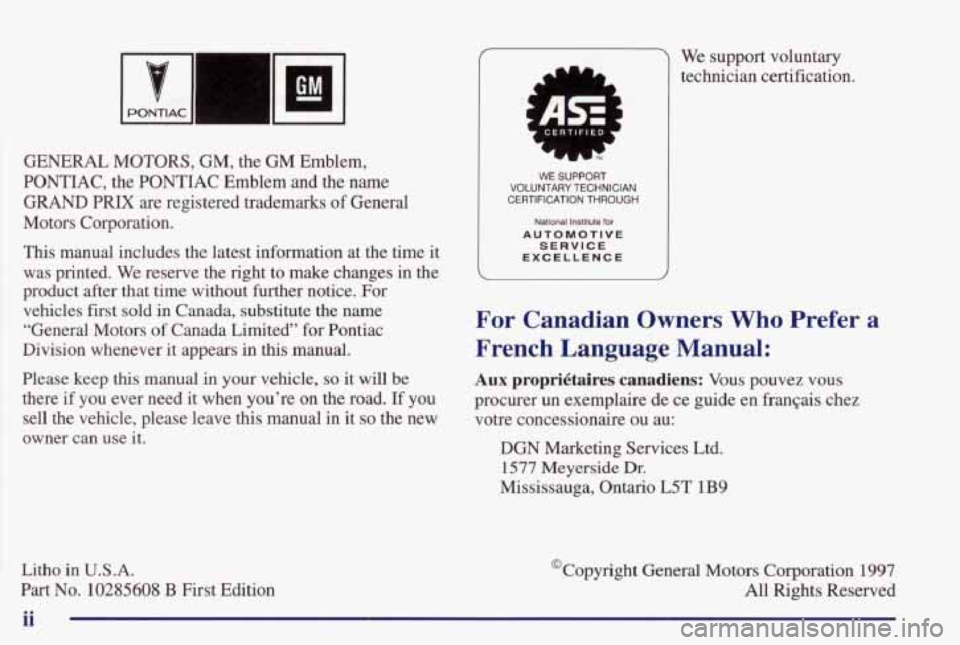
GENERAL MOTORS, GM, the GM Emblem,
PONTIAC, the PONTIAC Emblem and the name
GRAND PRK are registered trademarks of General
Motors Corporation.
This manual includes the latest information at the time it
was printed. We reserve the right to make changes in the
product after that time without further notice.
For
vehicles first sold in Canada, substitute the name
“General Motors of Canada Limited” for Pontiac
Division whenever it appears in this manual.
Please keep this manual in your vehicle,
so it will be
there
if you ever need it when you’re on the road. If you
sell the vehicle, please leave this manual in it
so the new
owner can use
it.
Litho in U.S.A.
Part No. 10285608 B First Edition
WE SUPPORT
VOLUNTARY TECHNICIAN
CERTIFICATION THROUGH
National InatiMe for
AUTOMOTIVE SERVICE EXCELLENCE
We support voluntary
technician certification.
For Canadian Owners Who Prefer a
French Language Manual:
Aux propriCtaires canadiens: Vous pouvez vous
procurer un exemplaire de
ce guide en franpis chez
votre
concessionaire ou au:
DGN Marketing Services Ltd.
1577 Meyerside Dr.
Mississauga, Ontario
L5T 1B9
@Copyright General Motors Corporation 1997
All Rights Reserved
Page 33 of 402

How does an air bag restrain?
In moderate to severe frontal or near-frontal collisions,
even belted occupants can contact the steering wheel or the
instrument panel.
Air bags supplement the protection
provided by safety belts.
Air bags distribute the force of
the impact more evenly over the occupant’s upper body,
stopping the occupant more gradually. But
air bags would
not help you in many types of collisions, including
rollovers, rear impacts and side impacts, primarily because
an occupant’s motion is not toward
those air bags. Air
bags should never be regarded as anythmg more than a
supplement to safety belts, and then only in moderate to
severe frontal or near-frontal collisions.
What will you see after an air bag inflates?
After an air bag inflates, it quickly deflates, so quickly that
some people may not
even realize the air bag inflated.
Some components of
the air bag module -- the steering
wheel hub for the driver’s
air bag, or the instrument panel
for the right front passenger’s bag
-- will be hot for a short
time. The parts of the bag that come into contact with you
may
be warm, but not too hot to touch. There will be
some smoke and dust coming
from vents in the deflated
air bags. Air bag inflation doesn’t prevent the driver from
seeing or from being able to steer the vehicle, nor does it
stop people from leaving the vehicle.
I
When an air bag inflates, there is dust in the air.
This dust could cause breathing problems for
people with a history
of asthma or other
breathing trouble.
To avoid this, everyone in the
vehicle should get out as
soon as it is safe to do so.
If you have breathing problems but can’t get out
of the vehicle after an air bag inflates, then get
fresh air by opening a window or door.
In many crashes severe enough to inflate an air bag,
windshields are broken by vehicle deformation.
Additional windshield breakage
may also occur from the
right front passenger air bag.
Air bags are designed to inflate only once. After they
inflate,
you’ll need some new parts for your air bag
system. If you don’t get them, the air bag system
won’t be there to help protect
you in another crash.
A new system will include air bag modules and
possibly other parts. The service manual for your vehicle covers the need to replace other parts.
1-26
Page 34 of 402

0
0
Your vehicle is equipped with a crash sensing and
diagnostic module, which records information about
the air bag system. The module records information about the readiness of the system, when the sensors
are activated and driver’s safety belt usage at deployment.
Let only qualified technicians work on your
air bag
system. Improper service can mean that your
air
bag system won’t work properly. See your dealer
for service.
NOTICE:
If you damage the covering for the driver’s or the
right front passenger’s air bag, the bag may not
work properly. You may have to replace the air
bag module in the steering wheel or both the air
bag module and the instrument panel for the
right front passenger’s air bag.
Do not open or
break the air bag coverings.
If your vehicle ever gets into a lot of water -- such as
water up to the carpeting
or higher -- or if water enters
your vehicle and
soaks the carpet, the air bag controller
can be soaked and ruined.
If this ever happens, and then
you start your vehicle, the damage could make the
air
bags inflate, even if there’s no crash. You would have to
replace the air bags as well as the sensors and related
parts. If your vehicle
is ever in a flood, or if it’s exposed
to water that soaks the
carpet, you can avoid needless
repair costs by turning
off the vehicle immediately.
Don’t let anyone
start the vehicle, even to tow it, unless
the battery cables are fist disconnected.
Servicing Your Air Bag-Equipped Vehicle
Air bags affect how your vehicle should be serviced.
There are parts of the air bag system in several places
around your vehicle. You don’t want the system to
inflate while someone is working on your vehicle. Your
dealer and the Grand
Prix Service Manual have
information about servicing your vehicle and the
air bag
system.
To purchase a service manual, see “Service and
Owner Publications” in the Index.
1-27
Page 35 of 402
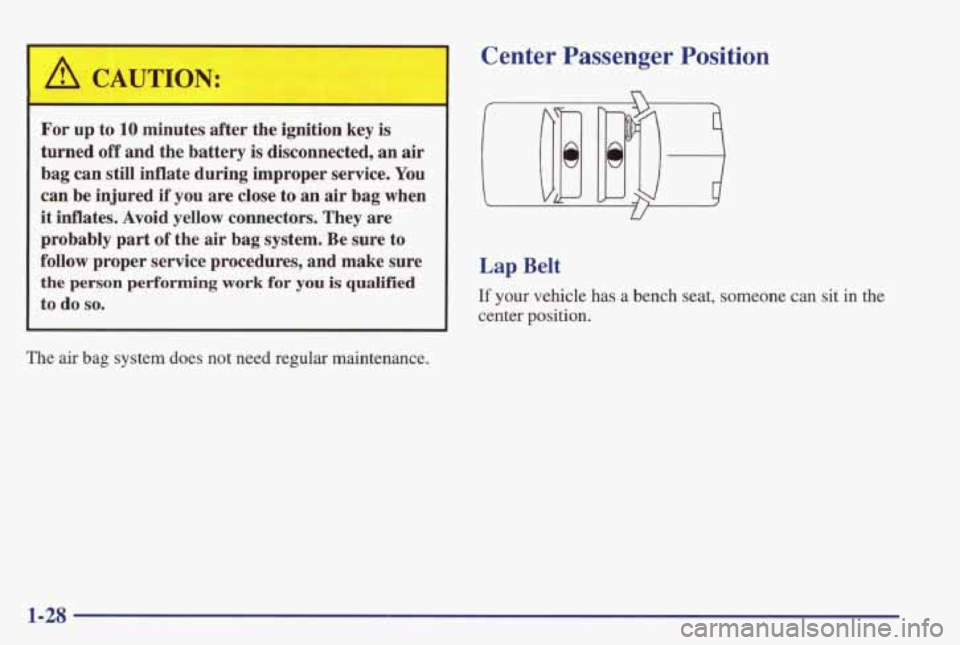
A CAUTION:
For up to 10 minutes after the ignition key is
turned
off and the battery is disconnected, an air
bag can still inflate during improper service.
You
can be injured if you are close to an air bag when
it inflates. Avoid yellow connectors. They are
probably part of the air bag system. Be sure to
follow proper service procedures, and make sure
the person performing work for you is qualified
to do so.
The air bag system does not need regular maintenance.
Center Passenger Position
i3
Lap Belt
U
If your vehicle has a bench seat, someone can sit in the
center position.
1-28
Page 54 of 402
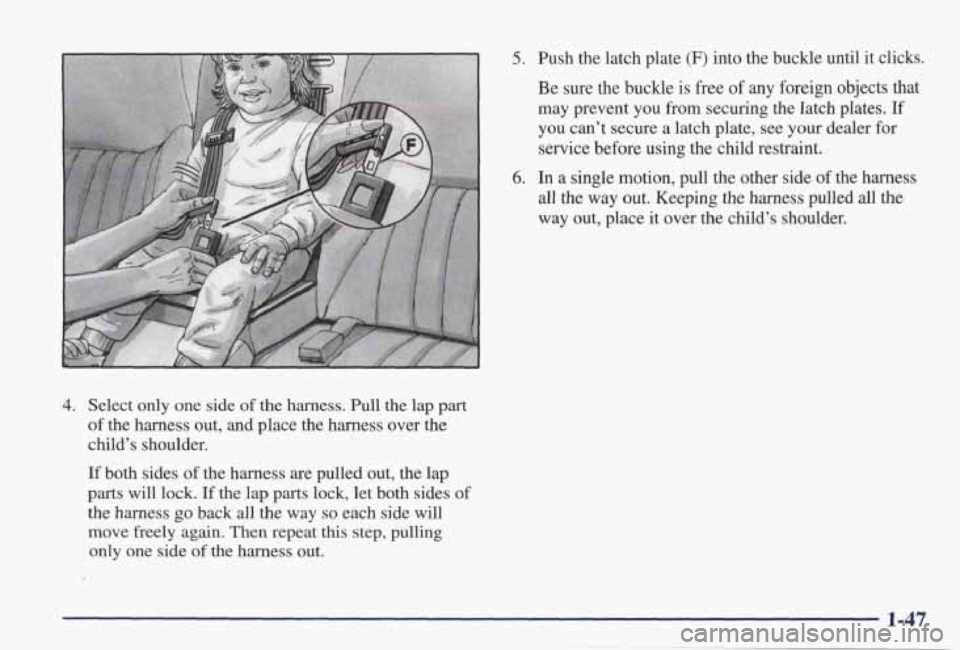
5. Push the latch plate (F) into the buckle until it clicks.
Be sure
the buckle is free of any foreign objects that
may prevent you from securing the latch plates. If
you can’t secure a latch plate, see your dealer for
service before using the child restraint.
6. In a single motion, pull the other side of the harness
all the way out. Keeping the harness pulled all the
way out, place
it over the child’s shoulder.
4. Select only one side of the harness. Pull the lap part
of the harness out, and place the harness over
the
child’s shoulder.
If both sides of the harness are pulled out, the lap
parts will lock. If the lap parts lock, let both sides of
the harness
go back all the way so each side will
move freely
again. Then repeat this step, pulling
only one side of the harness out.
Page 56 of 402
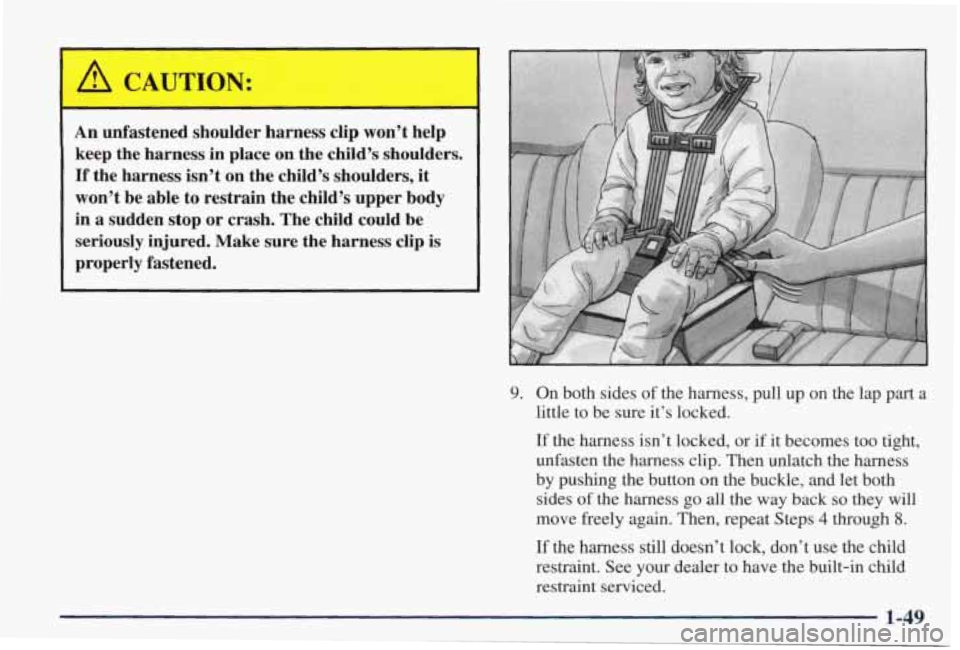
An unfastened shoulder harness clip won’t help
keep the harness in place on the child’s shoulders.
If the harness isn’t on the child’s shoulders, it
won’t be able to restrain the child’s upper body
in a sudden stop or crash. The child could be
seriously injured. Make sure the harness clip is
properly fastened.
9. On both sides of the harness, pull up on the lap part a
little to be sure it’s locked.
If the harness isn’t locked, or if it becomes too tight,
unfasten the harness clip. Then unlatch the harness
by pushing the button
on the buckle, and let both
sides
of the harness go all the way back so they will
move freely again. Then, repeat Steps 4 through 8.
If the harness still doesn’t lock, don’t use the child
restraint. See your dealer to have the built-in child
restraint serviced.
1-49
Page 78 of 402
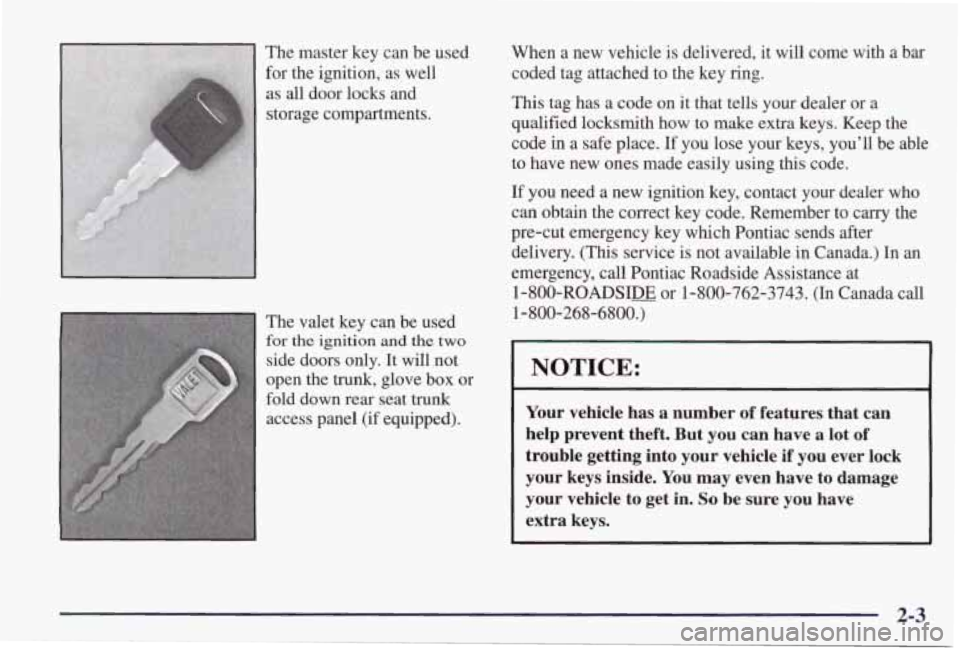
The master key can be used
for the ignition, as well
as all door locks and
storage compartments.
The valet key can be used
for the ignition and the two
side doors only. It will not
open the
trunk, glove box or
fold down rear seat
trunk
access panel (if equipped). When a new vehicle
is delivered, it will come with
a bar
coded tag attached to the key ring.
This tag has a code on it that tells your dealer or
a
qualified locksmith how to make extra keys. Keep the
code in
a safe place. If you lose your keys, you’ll be able
to have new ones made easily using this code.
If you need a new ignition key, contact your dealer who
can obtain the correct key code. Remember to carry the
pre-cut emergency key which Pontiac sends after delivery.
(This service is not available in Canada.) In an
emergency, call Pontiac Roadside Assistance at
1-800-ROADSIDE or 1-800-762-3743. (In Canada call
1-800-268-6800.)
I 1
I NOTICE: I ~~
Your vehicle has a number of features that can
help prevent theft. But you can have a lot
of
trouble getting into your vehicle if you ever lock
your keys inside. You may even have to damage
your vehicle to get in.
So be sure you have
extra keys.
2-3